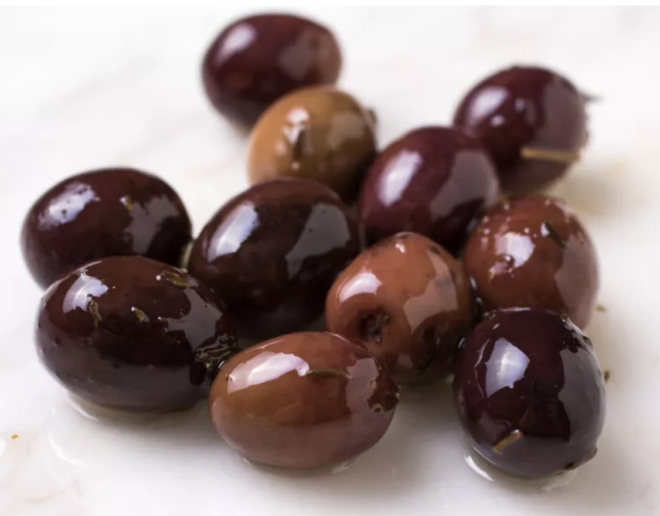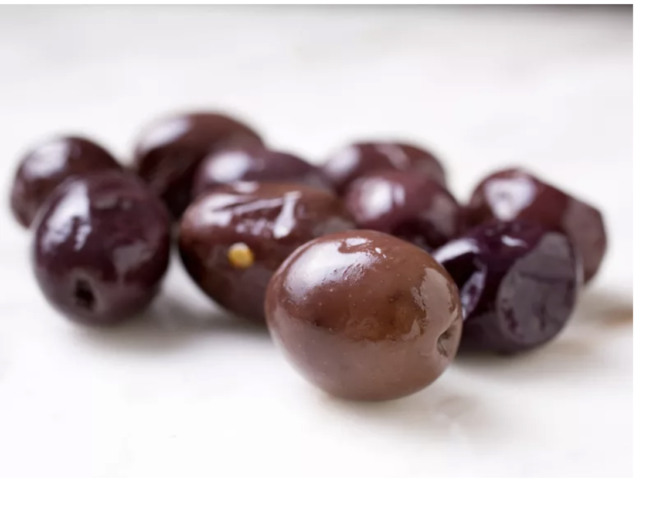Barnea, suri, kalamata? Your supermarket or farmer’s market usually offers a good variety of olives. Juicy green, black, brown or purple olives glistening in their own oil. Olives seasoned with chilies, lemons and herbs; olives pitted and left empty; olives stuffed with red pimentos; olives in brine or in wine marinade – enough olives to make your senses reel.
And like grape varieties for wine, there are more kinds of olives in the world than you’ll ever know. Every region where olives are grown yields a particular variety, each with its unique shape, size, and flavor.
What Are Olives, Exactly?
Are olives a fruit or a vegetable? Technically, an olive is a fruit. Well, a drupe to be specific. A drupe is a fruit that has a pit in the middle. In addition to olives, other drupe fruits include cherries, plums, and apricots.

Olives grow on trees, and unlike some other drupe fruit counterparts (like the cherry) raw olives picked right off the tree are not very tasty. This is because raw olives contain a phenolic compound known as oleuropein, which is very bitter. The fermentation or curing process is what makes olives so yummy and edible.
Also noteworthy – black and green olives are not different types of olives. They are the same, but their change in colors and flavors is based on the time they are harvested (black olives are riper than green ones). Now the next time the question, “What are olives?” comes up in a casual conversation, you’re ultra-equipped to wow your friends with your impressive knowledge about these beautiful morsels.
How Many Types of Olives Are There?
Considering olives have been cultivated for over 6,000 years, you might assume there are a lot of different types of olives. If so, you’ve assumed rightly. But how many types of olives are there? According to the International Olive Council (yes, there is such a thing, thank goodness!), there are about 139 types of olives, and they are grown in every continent save one (Antarctica). From kalamata to koroneiki, you’re bound to find the perfect olive that suits your fancy. The only trouble is – with so many olives from which to choose, how do you know which ones to pick? Read further for more details on all types of olives and varieties.
You should also know that it gets confusing to list the names of the olives grown even in relatively small cultivating areas, because one variety may be known by different local names, or different olives may go by the same name. To add to the confusion, some olives are grown for oil, some for the table, and some are sold to be consumed either way. An attempt is being made to sort out olive varieties via DNA identification.

Black olives are those that were allowed to ripen before harvest. In other words, all olives start out green, and grow darker as they ripen. Different varieties will mature into blue, red, brown, purple, or black. The flavor of the same olive will change the longer it stays on the tree. How it’s fermented and seasoned after the harvest changes its flavor too, and there are infinite ways to treat an olive, subject only to the imagination and local resources of the producer.
But buyer beware: all that’s olive is not gold. Canned black California olives are green olives that have been cured in a lye solution then treated with oxygen and ferrous gluconate to fix the black color. Harmless, but bland. Olives treated with lye cure quickly but have lost much of their original flavor.
Here are a few of the best-known olives, and one or two particularly popular in the Middle East.
Kalamata

A distinctive flavor from the kalamata region. Tastes like wine.
Kalamatas are the best-known Greek olive. Its color is deep purple and is often preserved in red wine. Sometimes you can find black or red Kalamatas.
Castelvetrano Olives

Castelvetrano, an Italian olive, said to be the country’s favorite snacking olive. It’s light green, meaty, and mild.
Manzanilla

Manzanilla or in Spanish “little apple.” Eaten green or black. One of Spain’s most popular varieties and often with a pimento inside. Since Spain is still the world’s largest olive exporter, it’s likely you’ve eaten Manzanilla olives, and can find them easily in the supermarket.
Beldi

Intense. Yummy. Chewy.
Beldi is the Moroccan olive dry-cured in salt. Black, shriveled, chewy, and with an intense flavor. The texture is comparable to that of sun-dried tomatoes. Salty, salty, salty! Pair Beldi olives with mild cheeses, fruit, and white or rose wines. Very good on pizza, although a pain to pit.
Gordal

The Gordal olive is the Queen of all olives.
Gordal often called “jumbo olives.” Gordals come from Sevillia, Spain, and are cured while green. They’re handy for stuffing with cheese, almonds, cured meat, capers… anything you think will taste well inside these huge olives.
Picholine

Small, nutty picholine olives from France.
Picholine. Small, green, and with a nutty flavor, picholine olives originated in France but are now grown all over the world.
Suri olives

Suri olive from Lebanon. A favorite in the Levant region.
Suri olives originated in Lebanon and considered to be one of the oldest varieties. It’s harvested green and produces a peppery oil.
Barnea

Barnea olives are a favorite in Israel
Barnea is an olive variety claimed by Israel. Nowadays the Barnea is grown in Argentina and Australia too. Grown mostly for its mild, fruity oil.
Gaeta

Gaeta olives come from Italy. They’re small and oval-shaped. Black Gaetas are salt-cured, which gives them a wrinkled texture. Brine-cured Gaetas are smooth and dark violet color. After curing, Gaetas are stored in olive oil.
Leccino

Leccino olive trees, are drought tolerant olives that came from Tuscany, although today Leccinos are cultivated around the world. They have a light brown skin and a unique sweet/spicy flavor.
Mission Olives

Mission olives are the only American variety recognized by the International Olive Council. Tradition has it that Franciscan missionaries from Spain brought the trees to California in the late 1700s. The fruit is small, harvested while green, and considered an endangered heritage variety by the Slow Food movement.
Cerignola

Named after the town in Italy from which they are harvested, the Cerignola is a green jewel that is mild and makes a perfect parcel for stuffing. Gently remove the pit and stuff with primo partners such as cheese, capers, garlic, or anchovies. Because of their mild yet complex taste, they blend well with bold flavors so they make a great feature in antipasti or cheese platters.
Nyon

Dry cured and then aged in brine, these wrinkly, flavorful gems are growing in the south of France. They have a slightly bitter taste that works well when tossed into salads. You can also cook with Nyon olives, which bring out a heady aroma in comfort food dishes such as casseroles or roasty veggies.
Niçoise

These dark beauties are born in the Provence area of France, and are best known for their leading role in Niçoise salad, which is a freshy-fresh French tuna salad. The Niçoise olive is also commonly found in tapenade because its flavor can stand tall yet also blend, especially when mixed with fine olive oil, anchovies, and capers. These types of olives possess a bold flavor, but not so bold as to overpower.
Liguria

Whether cooked or uncooked, the Liguria is a versatile olive with a rich, deep flavor. This type of olive is typically cured with intoxicating aromatics such as rosemary, bay, and thyme. These olives come from the northwestern region of Italy and they come in both green and black varieties. Because they are so versatile, you can concoct a variety of culinary feats with them. Top them on your pizza for a lightly piquant flavor or toss them in your pasta dishes or salads. These olives are also great companions for poultry and fish accents.
Alfonso
Lovingly cultivated in the foothills of La Yarda mountains in Chile, the Alfonso is a purple pearl in the olive family. These babies are big, beautiful, and a bit bitter. Their acerbic taste is attributed to the brine-curing process that involves submersion in either vinegar or wine. Because they can be a bit puckery in taste, these types of olives are mostly used as a flavor enhancer in soups, stews, or other cooked comfort foods.
Amfissa

Hailing from the ancient, prophetic hills of Delphi, the Amfissa olive is a treasure to the Greek population. Thankfully, these glories are imported, so we can all savor these mild, fragrant, melty, juicy flavor bombs. Picked at the peak of ripeness, these black and green olives are a perky addition to cheese plates and charcuteries. The Amifissa olive has a bright flavor that is scrumptious on its own, but it can also be used to flavor stews, casseroles, or soups.
What Is The Most Common Type of Olive?
Hands down, the kalamata olive (and all its varieties) is the most commonly recognized olive. Their popularity is mostly due to their versatility because they are used for a buffet of different culinary specialties. From the topping on your pizza to Mediterranean salads or as an accent for drool-worthy Italian dishes – the kalamata is a royal champion in the olive world.
Perhaps the kalamata’s fame is due to its rich, smokey, lively flavor. Or maybe it’s because the Greeks have cultivated, cured, and preserved these olives with a standard of excellence that is beyond reproach. You be the judge. Try them in your next tapenade or appetizer plate before cocktails. Serve them in a salad, or top them on your next pita bread sensation. You’ll quickly understand why these are top on the leaderboard as olive fan favorites.
What Are the Best Type of Olives to Eat?
Where do we begin with this question? If you ask us, all olives are worth savoring. However, there are some that are more inclined toward tastebud pleasures than others – depending upon your end-purpose. For example, if you want the best health benefits of olives, choose kalamatas. Aside from the fact that kalamatas are delicious, their health benefits are one of the main reasons these olives are so popular around the world. To explain, the kalamata is like having vitamin B12 supplements in your back pocket, because these beauties are packed with this vitamin more than many of their counterparts.
In terms of flavor, the best type of olives to eat are the ones that suit your epicurean fancy. For instance, you might want to grab a jar of Manzanilla olives. These are typically stuffed (usually with pimentos), but they have a sharp, bitey flavor that is undeniably delicious when paired with a bloody mary or spiced homestyle dishes such as paella.
However, if you’re a purist, you might want to lean towards the Castelvetrano olive. This is an ace olive as a stand-alone due to its tart, scintillating flavor for snacking. It’s also a winner as a fine-dining accent.
What sort of health benefits do olives offer?
If you know about the benefits of olive oil, then the same applies to olive (the fruit) health benefits. Olives are cram-packed with vital nutrients such as vitamin E, A, calcium, and iron. Olives are also high in antioxidants. Studies on Mediterranean diets have revealed that the nutritional value of olives supports health in various ways, such as improving heart health, preventing diabetes, and even reducing the risk of some cancers. While olives are clearly beneficial to our health (and tasty), you should consult your physician or nutritionist to get the full scoop on how olives can improve your health.
Which country produces the best olives?
We don’t want to ignite a worldwide debate here, but common opinion seems to lean towards Spain as the country that produces the best olives. This is likely due to the country’s ideal climate conditions that nurture olives to sublime perfection. Of course, you’ll have your own opinion about the best source of olives. To wit, Greece and France are arguably some of the best purveyors of some of the most pristine olives (and olive oil) on the face of the planet. The best way to answer this question is to sample different olives from different countries and judge for yourself!
Which olives are buttery?
If you’re not sure about the best-tasting, buttery olive, then grab some Castelvetrano or Cerignola olives. These are by far the most melt-in-your-mouth, delectable choices for that rich, toothsome awesomeness you crave from olives. If you can’t locate these two particular buttery olives, you can always lean on the popular favorite – kalamata. It will provide you with the salty, soft, sensual flavor you can depend upon in a well-cured olive, and yes, it’s buttery too!
What is the sweetest olive?
When you think of olives, you might not think of sweetness. However, certain olives have a milder, more fruity, or sweet tinge in their taste that is worthy of recognition. While every taste preference is different, the International Olive Council deems the Cerignola as top-notch in terms of sweetness. You might also want to sample the Portuguese Galega olive, which is a sweet, juicy, rich, and resonant olive that is arguably a tasty treat on any table.
Which Olives Have the Strongest Taste?
There is not much debate about this – the strongest-tasting olives are typically of the green variety. Because they are plucked during their early development, green olives have a tangy, tart, titillating taste-twinge that can’t be denied. Having said that, you may find kalamata (which are black) to have a pinchy, strong flavor because they are preserved in puckery solutions such as vinegar or wine. Nevertheless, we still hold firm on our opinion that greenies such as the Castelvetranos olive grown in Sicily have that punch of bitey flavor if you’re looking for a strong sensation on the tongue.
Make your own olive marinade

Make your own tasty marinade, no matter what olives you have at home.
Want to make your own marinated olives, like the ones pictured above? Here’s a recipe.
Marinated Olives Recipe
Ingredients:
2 cups olives, either one variety or an assortment of different colors and sizes
1/2 cup extra virgin olive oil
Peel of 1 large lemon
2 large garlic cloves, thinly sliced
1 large bay leaf, broken up, or 2 small whole bay leaves
1/2 teaspoon crushed, dried thyme, or rosemary, or oregano, or za’atar
1 tablespoon coriander seeds
2 tablespoons red wine vinegar
Optional: 1/4 – 1/2 teaspoon chili pepper flakes, or to taste






That was a copy & paste from the instructions on Pea Pod Wine.
Sterilize a one-gallon bucket – wash it with very hot water and soap, rinse extremely well, then use a Campden tablet rinse as per instructions. Also clean and sterilize a strainer and a long-handled spoon. No wooden spoons! It’s impossible to get rid of vinegar-making bacteria from a wooden spoon. You can sterilize the strainer and spoon in the bucket at the same time.
Great ideas! Thanks for sharing. And What is your favorite type of olive?